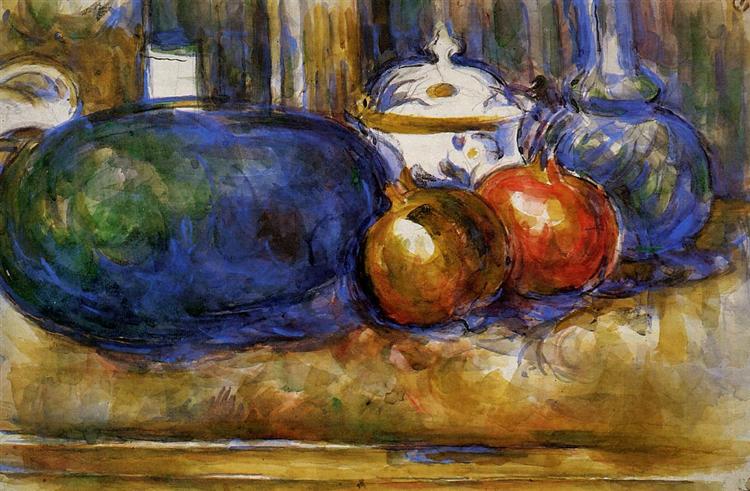תיאור
Paul Cézanne's painting "Still Life with Watermelon and Pomegranates", painted in 1906, is a work that encapsulates the essence of the Post-Impressionist master's innovative approach to still life. In this composition, Cézanne demonstrates his unrivaled ability to balance form and color, creating a dynamic dialogue between the depicted objects and the space around them. The work features a meticulous arrangement of fruits, in which the watermelon, cut into sections, and the pomegranates, with their vibrant and juicy appearance, immediately capture the viewer's attention.
The use of colour in this work is remarkable. The painter employs a rich, saturated palette ranging from the deep reds of pomegranates to the green and pink of watermelon. Known for his desire to understand the underlying structure of nature, Cézanne is not only interested in depicting the surface appearance of fruits, but seeks to highlight their volume and the interaction of light on them. The complexity of tones and shades creates a sense of three-dimensionality, a characteristic feature of Cézanne's style that distinguishes his work from the flatter compositions of the Impressionist period.
The arrangement of the elements in the painting is equally significant. Cézanne seems to defy the law of gravity and traditional expectations of composition. The fruits are not aligned in a conventional manner; instead, they are arranged in an arrangement that provokes an intense, almost meditative gaze. This asymmetrical arrangement infuses the work with a vibrant energy, suggesting that the objects are in a constant state of transformation, in tune with the very nature that Cézanne so admired. The table on which the fruits rest is also crucial; its surface seems to almost vanish, defying geometric norms and lending a sculptural quality to the elements depicted.
Importantly, while the painting does not feature any human figures or characters, the visual narrative that is created is deeply evocative. The work invites the viewer to contemplate not only the beauty of the fruits, but also the complexities of the environment that surrounds them. Cézanne, with his almost philosophical approach to painting, manages to convey an intimate connection between the objects and the viewer, making each element a starting point for reflection on nature and perception.
In terms of its place in art history, Still Life with Watermelon and Pomegranates aligns with the late period of Cézanne's work, where his search for simplification and essence becomes most apparent. This work forms part of his legacy as a precursor to Cubism and as a central figure who broke with the conventions of 19th-century art. Its influence is undeniable, resonating with generations of later artists who explored form, color, and composition in new ways.
The work is currently in a private collection, but its significance lies not only in its technique, but in how it encapsulates the ethos of an artist who dedicated his life to understanding and rendering the complexity of the visible world. Still Life with Watermelon and Pomegranates is not only a testament to Cézanne’s virtuosity, but also a reminder of his eternal relevance in the conversation about contemporary art and his influence on the development of later artistic movements.
KUADROS ©, a famous painting on your wall.
Hand-made oil painting reproductions, with the quality of professional artists and the distinctive seal of KUADROS ©.
Painting reproduction service with satisfaction guarantee. If you are not completely satisfied with the replica of your painting, we will refund 100% of your money.

